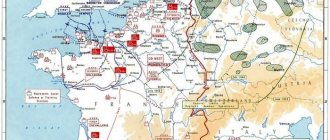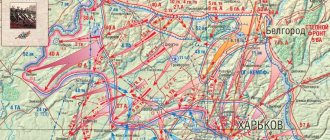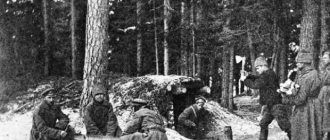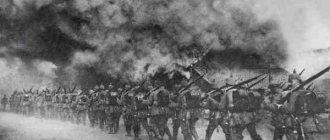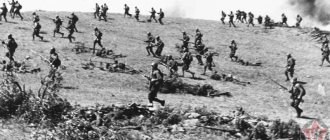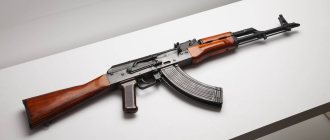In December 1944, the German command completed the development of an operation with the goal of defeating the Anglo-American troops on the Western Front and freeing up forces to continue the war against the USSR. The German Army's offensive in the Ardennes, called "Watch on the Rhine", began at dawn on December 16, 1944.
Commander of the 6th SS Panzer Army, Obergruppenführer (Colonel General of the SS troops) Joseph (Sepp) Dietrich during the award ceremony for distinguished soldiers
To carry out Operation Watch on the Rhine, to which A. Hitler attached great importance, the Germans withdrew large forces from all fronts and formed two tank armies (5th and 6th SS) armies, with a large number of new medium and heavy Panther tanks " and "Tiger", as well as self-propelled guns "Yagdpanther" and "Yagdtiger". The operation also involved the 7th Army of Army Group B (group commander Field Marshal V. Model), already badly battered in the Battle of Normandy. The advancing group consisted of about 250 thousand people, 900 tanks, 800 aircraft, more than 2.6 thousand guns and mortars. The overall command of the operation was exercised by Field Marshal G. von Rundstedt.
SS shock fist
The main actions were to unfold on the front of the 6th SS Panzer Army (commander Obergruppenführer S. J. Dietrich), the 5th Panzer Army was advancing in the center (commander General H. von Manteuffel), the left flank was covered by the 7th Army (commander General E. Brandenberger). The main striking force of the 6th SS Panzer Army was the 1st SS Panzer Corps (SS Panzer Division "Leibstandarte" and 12th SS Panzer Division "Hitlerjugend"), in reserve was the 2nd SS Panzer Corps (2nd SS Panzer Division "Reich" and 9th SS Panzer Division "Hohenstaufen"). The army also included: the 12th, 272nd, 277th, 326th Grenadier Divisions and the 3rd Parachute Division.
The 1st American Army of Lieutenant General K. Hodges from the 12th Allied Army Group (commanded by General O. Bradley) that opposed the Germans had 83 thousand people, 424 tanks, and over 390 guns.
An attempt to repeat the breakthrough “French style”
The general meaning of Operation Watch on the Rhine was that a powerful strike, delivered by large forces of tank and motorized formations, was aimed at breaking through the positions of the 1st American Army and capturing the strategically important port of Antwerp. After which the Germans could encircle and cut off from sources of supply a large group of allied forces in Holland (the Netherlands) and Belgium. In general, the operation resembled the attack on France in 1940.
German soldiers run past abandoned American equipment. Ardennes. December 1944
Tanks in the snow
— From the very moment of the landing in Normandy in the summer of 1944, the USSR’s allies in the anti-Hitler coalition, the USA and Great Britain, significantly outnumbered the Germans in the number of soldiers and military equipment. The advantage was so great that the Allied staff forgot to think that the Wehrmacht was still capable of anything other than defense and retreat. But in vain. On December 16, the Nazis on the Western Front carried out their first strategic offensive operation since 1940. True, she also became the last.
German armored vehicles during the Ardennes offensive. Photo: wikipedia.org
Article on the topic
Poison for the Fox. Why did Hitler condemn his beloved commander to death? The Ardennes is a mountain-forest area on the border of Belgium, Luxembourg and Germany, which is still considered the “lungs of Europe”. In 1944 there were even fewer roads there than there are now, and there were even more natural barriers to attack. The Allied defense in the Ardennes was held by 4 American divisions (about 80 thousand people), two of which had no combat experience, and two had previously suffered heavy losses and were withdrawn to a “quiet area” to recuperate. They were opposed by 20 Wehrmacht and SS divisions, including 7 tank divisions, and later 7 more were added! In total, the Germans collected 300 thousand people, more than 1000 tanks and assault guns.
Hitler's idea, which initially smacked of an adventure, was to bloodlett the Allies and thereby force them to sit down with the Germans at the negotiating table. After this, he believed, it would be possible to transfer all forces to the Eastern Front and stop the Russian advance...
German soldiers passing by abandoned American equipment. Photo: wikipedia.org
In the first days, the Germans had a threefold advantage over the Americans. Because of this, and also because of the low clouds that kept Allied aircraft grounded, the Nazis were initially successful. The offensive was so unexpected that news of it did not reach Dwight Eisenhower, the Supreme Commander of the Expeditionary Forces in Europe , until evening. Columns of American prisoners reached the German rear.
Success in surprise
The blow inflicted by German units took the Allied forces by surprise, since the Anglo-American command considered the Ardennes region unsuitable for conducting broad offensive operations. However, soon General D. Eisenhower ordered the entire front to stop attacks and sent all reserves to the sides of the deepening German tank wedge. He then ordered General J. Patton's US 3rd Army to advance towards the city of Bastogne. In addition, he transferred the 1st American Army and part of the 9th Army to the commander of the 21st Army Group, Field Marshal B. Montgomery, entrusting him with the fight on the northern flank of the wedge.
American troops pass a railway bridge north of Bruggenbach, Belgium, which was blown up by retreating Germans
On December 17, the battle entered a critical phase, as the extremely important road junction on the southern front - the city of Bastogne - was still firmly held by the American 101st Airborne Division, and the flanks of the German wedge were compressed so tightly that the Germans could not expand the base their actions and thereby provide room for maneuver. The largest victory of the advancing units in five days of fighting was the encirclement of the city of Bastogne. On December 22, envoys arrived at the besieged garrison with a demand to surrender on honorable terms, which was rejected.
Effective air force strike
The successful start of the German operation was facilitated by the fact that bad weather deprived the Allies of absolute air superiority, preventing most of their aircraft from taking off. In addition, the Germans managed to carry out a number of successful acts of sabotage in the rear of the advanced units of the American armies. However, on December 24 the weather cleared. This largely decided the future fate of the German offensive. Almost 5 thousand Allied aircraft rushed into the battle area and rained bomb and machine-gun fire on enemy troops and communications. As one Allied general later wrote: “Hundreds of our planes headed for the supply lines that would carry the supplies Rundstedt needed to continue his offensive or at least stay where he was.”
American heavy fighters Lockheed P-38 Lightning are sent to attack ground targets
The offensive stalled
By December 25, German tank columns had already advanced 90 km into the depths of the Allied defenses. The advanced units reached the area of the city of Dinan and were 4 km from the Meuse River. However, later the German troops slowed down the pace of the offensive, and this allowed the Allied command by the end of December to transfer formations from other sectors of the front to the breakthrough area and stop the enemy’s advance with a counterattack. On December 26, the approaching American division linked up with the garrison of Bastogne, and the siege of the city was lifted. By the end of January, the German offensive in the Ardennes had fizzled out, and they were forced to retreat to their original positions.
American tanks advance during heavy fog to "break the spearhead" of the German advance
Allied losses in the Ardennes operation amounted to about 77 thousand people killed and wounded. With Operation Watch on the Rhine, the Germans delayed the general Allied offensive on the Western Front by six weeks. This last desperate but unsuccessful attempt by A. Hitler to change the course of the war cost the Wehrmacht about 82 thousand people killed and wounded.
On July 16, 1950, a memorial complex dedicated to the American soldiers who fell in the Battle of the Bulge took place in Bastogne (Belgium).
Loyalty to allied duty
On January 6, in connection with the difficult situation of the Allies in the Ardennes, W. Churchill turned to I. Stalin with a request to provide assistance.
The message from the British Prime Minister emphasized: “Very heavy fighting is going on in the West, and at any time big decisions may be required from the High Command... It is very desirable and necessary for General Ejaenhauar to know in general terms what you propose to do, since this, of course, will be reflected in all his and our most important decisions... I will be grateful if you can tell me whether we can count on a major Russian offensive on the Vistula front or anywhere else during January or at any other points about which you, You might want to mention... I consider the matter urgent.” On January 12-13 (8 days earlier than planned), the Red Army launched a simultaneous offensive in Poland and East Prussia. The German command was forced to stop the offensive on the Western Front and transfer 13 divisions (including tank divisions - 800 tanks) to the Eastern Front in the second half of January. Share link
Ardennes operation 1944. Adolf Hitler's last chance for a separate peace
Exactly seventy years ago, on December 16, 1944,
at 4.00 in the morning,
the advanced American units on the calmest section of the Western Front in the Arden Mountains woke up from the roar of cannonade and saw in front of them people in the uniform of US Army soldiers and officers rushing to the rear in American jeeps. They shouted to them: “Run, save yourself, the Germans have broken through the front and are advancing!” These were German saboteurs from the special squad “Grif”, staffed by English-speaking soldiers from units of the German Wehrmacht, commanded by Obersturmbannführer (Lieutenant Colonel) “SS” Otto Skorzeny.
Even in the initial stages of planning the German counteroffensive in the Ardennes
German Fuhrer Adolf Hitler repeatedly emphasized the importance of capturing bridges over the Meuse River before they were destroyed.
Having considered all possible options, he turned to the idea of creating a special unit
that would have to capture the bridges. According to him, this formation, dressed in American uniforms and having American weapons and vehicles, was supposed to, using the surprise of the German breakthrough and stunning the enemy, move to the bridges over the Meuse, posing as retreating Americans.
The commander of this unit was to be SS Sturmbannführer Otto Skorzeny
, famous for the 1943 release of the Italian Duce Benito Mussolini, imprisoned in a seemingly impregnable hotel in the Alps. Having barely returned from another special operation - the kidnapping of the son of the Hungarian regent Horthy and the seizure of the government residence in Budapest, Skorzeny was summoned on October 22, 1944 to the Fuhrer's headquarters in Rastenburg. Hitler congratulated him on his promotion to the rank of SS Obersturmbannführer, and then spoke about the upcoming offensive and the role he would play in it.
Otto Skorzeny himself later told
, that he had only four American reconnaissance vehicles, about 30 jeeps and about 15 real American trucks, so he “had to camouflage the German trucks so that they were indistinguishable from the American ones. The only thing these vehicles had in common was that they were painted green, like American army trucks.” The situation with weapons was worse - American weapons were only enough for a sabotage company.
Since the landing in Normandy
in the summer of 1944, the USSR's allies in the anti-Hitler coalition - the USA and Great Britain - significantly outnumbered the Germans in the number of soldiers, material support and military equipment. The superiority of forces was so great that many Allied staff officers, despite intelligence warnings, firmly believed that the Wehrmacht was incapable of active and large-scale offensive actions, and therefore would only defend itself and slowly retreat. As it turned out, they miscalculated, since on December 16 the Wehrmacht carried out its first strategic offensive operation on the Western Front since 1940. True, it also became his last.
By the end of 1944, Allied troops
have already reached the borders of Germany, which was regularly subjected to massive air raids by Anglo-American aircraft, destroying its military industry, infrastructure and cities. The situation for Nazi Germany became catastrophic. After the summer-autumn battles of 1944, the Red Army stood at the eastern gates of the Reich. In the West, the Allied forces liberated Normandy and Southern France, Belgium in the summer, and in the fall, advancing through the Vosges Mountains, they liberated most of Alsace and Lorraine (northeast France) and reached the Rhine, preparing for a decisive offensive into the interior of Germany.
The Ardennes is a mountain-forested area
on the border of Belgium, Luxembourg and Germany, which is still considered the “lungs of Europe”.
In 1944 there were even fewer roads there than there are now, and there were even more natural barriers to attack. The Allied defense in the Ardennes was held by only 4 American divisions
(about 80 thousand people), two of which had no combat experience at all, and two had previously suffered heavy losses and were withdrawn to this “quiet area” for rest and recuperation.
They were opposed during the Arden operation
20 German divisions of the Wehrmacht and SS troops, including 7 tank divisions, to which 7 more divisions were later added.
In total, the Germans assembled a “shock fist” of 500 thousand people, more than 1,800 tanks and assault guns, 1,900 artillery pieces and Nebelwerfer rocket launchers and 800 aircraft. The Wehrmacht's operation, Ardennnenoffensive, was codenamed "Wacht am Rhein".
In the USA this operation is called the “Battle of the Bulge”, in the UK it is called the “Battle of Ardennes”.
To carry out the Ardennes operation
The German command created two attack groups: the Northern group (6th SS Panzer Army, commander SS Oberstgruppenführer Sepp Dietrich) and the Southern group (5th Panzer Army of General Manteuffel, 47th and 58th Panzer Corps, 66th Army frame). The 6th SS Panzer Army and the 5th Panzer Army concentrated a large number of medium Panther tanks and heavy Tiger and King Tiger tanks, as well as Jagdpanther and Jagdtiger self-propelled guns. The 7th Army (E. Brandenberger, 80th and 85th Corps), advancing on the left flank, also took part in the operation. These three armies were part of Army Group B (Heeresgruppe B, commanded by Field Marshal V. Model), located opposite the Ardennes. The German group consisted of 24 divisions, including 10 tank divisions, as well as individual units. Army Group X (Heeresgruppe H, J. Blaskowicz) was located north of the Ardennes. It included the 15th and 25th Armies and the 1st Parachute Army. Army Group G (Heeresgruppe G, P. Hausser) was located south of the Ardennes. It included the 1st and 19th armies.
The idea of the German Fuhrer Adolf Hitler
, which initially smacked of an obvious adventure, which was pointed out to him by some military generals who were immediately dismissed by him, was to arrange a “big bloodletting” for the Anglo-American allies and, thereby, force them to sit down with the Germans at the negotiating table to conclude separate peace. After this, Adolf Hitler believed, it would be possible to transfer all German forces to the Eastern Front, where they would stop the advance of the Red Army.
The Germans' first target was the bridges over the Meuse River.
, which separated the Ardennes from the rest of Belgium and without the capture of which further advance was impossible due to the terrain. Then they planned to attack Antwerp, through the port of which the 21st Army Group was supplied, and the capital of Belgium, Brussels. The German command relied most on its heavy armored vehicles (Tiger-VI and Tiger-VIB tanks) and bad weather - due to constant snowfalls and heavy clouds, Allied aviation could not operate for several days and this temporarily negated the Allied air superiority. The Germans hoped to make up for the fuel shortage by capturing captured fuel from the Allies in warehouses in the cities of Liege and Namur. The bridges across the Meuse were defended by units of the 30th British Corps, were mined by sappers and were ready to be blown up in case there was a threat of their capture by the Germans.
According to some reports, American intelligence
It became known in general terms about the plans for the German offensive back in November 1944, since it used the “ULTRA” system for deciphering German radiograms, and thanks to aerial reconnaissance, the Americans knew about all the movements of German troops and their concentration east of the Ardennes. Therefore, the American command prepared in advance to repel the enemy’s attack by placing large mobile groups of its troops north and south of the Ardennes, and in the Ardennes itself it deliberately weakened the defenses, leaving the 28th and 106th infantry divisions there.
Everything happened exactly as expected
American commanders - German troops went on the attack in the Ardennes, where the Allies deliberately weakened the defenses, and when the Germans broke through almost 100 kilometers to the West, American troops attacked them with their mobile groups of the 1st and 3rd armies from the flanks - from the North and South , putting the Germans at risk of encirclement. It is clear that an offensive in the form of a “wedge”, when they are simultaneously attacked by mobile enemy forces from the North and South, could only end in a “cauldron” for the Germans. The German command made a serious mistake by launching an offensive in the Ardennes - it was an offensive by the desperate.
The Allied command had significant reserves
for a timely response to a German breakthrough anywhere on the front, including in the Ardennes. In France, the 15th American Army was formed from divisions arriving from the United States. Having completed its formation, it was sent to the front at the beginning of 1945. The total number of American troops in the area of the Ardennes operation reached 840 thousand people with 1,300 tanks, 182 self-propelled anti-tank guns and 394 artillery pieces.
But in the first days of the offensive, the Germans had
threefold advantage over the Americans. Because of this, and also because of the low clouds that kept Allied aircraft grounded, the German divisions were initially successful. Long columns of American prisoners of war reached the German rear. The offensive was so unexpected for the Americans, despite intelligence warnings, that news of it reached General Dwight Eisenhower, the Supreme Commander of the Expeditionary Forces in Europe, only in the evening of the same day.
Among the Allied reserves
, which could be used almost immediately, was the 18th Airborne Corps under the command of General Ridgway, stationed near Reims. The corps included the 82nd and 101st Airborne Divisions, already battle-tested formations. Shortly before this, they had fought heavy battles in Holland and had not yet fully recovered. By order of Eisenhower, the 18th Corps was immediately redeployed to the Bulge.
101st Airborne Division
held the defense in the city of Bastogne - the German 5th Panzer Army repeatedly attacked from different directions, but was unable to take the city. The defense of Bastogne seriously hampered the German advance, as seven main roads in the Ardennes, which were necessary for their supply, intersected there.
US 7th Armored Division
for 5 days it held the city of Saint-Vith near the Belgian-German border in the northern section of the Ardennes salient. This small city was also the crossing point of important roads in the Ardennes - according to the plan, the Germans expected to take it at 18:00 on the evening of December 17, but this was only possible on December 21.
Such delays were unacceptable for the Germans
. American troops retreated and abandoned the city, but the defense of the city of Saint-Vith also greatly slowed down the German advance. But the Allies held Bastogne. The defense of both cities slowed down the pace of the German offensive, and made it possible for the Allies to transfer additional troops to the Ardennes.
December 19, 1944 General Eisenhower
convened a meeting in Verdun to discuss the circumstances resulting from the German counter-offensive. A week before these events, on December 12, General Patton discussed the possibility of a German breakthrough from the left flank of his army in the First Army sector, as a result of which a counteroffensive plan for the 3rd Army was developed in case of such an enemy action. The US Third Army launched a counteroffensive, attacked German troops from the South, and began to advance towards the city of Bastogne to assist the 101st Airborne Division.
By the end of December 1944 the weather had improved
and Allied aircraft began to strike at the advancing Germans, bombing the supply lines of German troops, who were experiencing an acute shortage of fuel, since they were unable to capture fuel depots in Liege and Namur. They could not even achieve the first goal of the operation - the capture of bridges over the Meuse River, since they did not reach the river. Meanwhile, American troops, reinforced by redeployment from other sectors of the front, launched a counterattack with the 3rd American Army from the South in the direction of the city of Bastogne, and the 1st American Army, together with the 30th British Corps, completely stopped the enemy advance. The 101st Airborne Division in Bastogne held back the enemy onslaught and was relieved by units of the 3rd American Army.
The Wehrmacht offensive stalled near the Belgian city of Selle
(Celles) on the morning of December 25, 1944, just 6 kilometers from the Meuse River and the bridge in the city of Dinan. It was the “spearhead” of the Ardennes salient, that is, the westernmost point of the German offensive in the Ardennes. Here the 2nd German Panzer Division, advancing in the vanguard of the 5th Panzer Army, was encircled near the city of Selle, and the 2nd German Panzer Division was surrounded by the 2nd American and 11th British Panzer Divisions. This was a rare case in history for two divisions of opponents with the same numbers to clash in battle.
By December 25, 1944, the strategic operation of German troops
in the Ardennes ended in complete failure. They did not even complete tactical tasks - they could not capture the bridges over the Meuse River, and did not even reach the river itself. Despite Hitler's orders to continue the offensive, German troops began to retreat. The “last blitzkrieg” of the German Wehrmacht has ended.
But on January 1, 1945, the German command
, counting on the loss of vigilance by the Americans celebrating the New Year, decided to launch a massive air strike on enemy airfields and thus reduce Allied air superiority.
Me262
jet fighters and
Ar234 Blitz
) on Allied airfields, at least 260 aircraft were destroyed, but the Luftwaffe also lost more than 200 aircraft from Allied aviation and anti-aircraft crews. On the same day, January 1, 1945, the Germans again went on the offensive - this time in Alsace in the Strasbourg region in order to divert the Allied forces, but these were only distracting attacks of a local nature, carried out by small forces - German troops were already in the Ardennes retreated with all their might. The Wehrmacht lost its strategic initiative irrevocably.
Thus, the Nazi offensive
With great difficulty, the allies managed to stop it only after 10 days, having transferred 30 divisions from other sectors of the front. Already on January 3, 1945, the Allies launched a counteroffensive and by the end of January 25, they had regained all the territories captured by the Wehrmacht during Operation Watch on the Rhine. The German offensive ended in a crushing failure, and the Wehrmacht only wasted its last resources. Both sides lost approximately 100 thousand people, for US troops this operation became the bloodiest of the entire war.
Despite the fact that the German command
did not achieve the desired results, the Ardennes operation delayed the offensive on the Rhine
for 6 weeks
: the Allies planned the offensive for December 18, 1944, but they had to postpone it to January 29, 1945. However, thanks to this, the Allies suffered fewer losses: the German troops were defeated in open terrain, where it was easier for the mobile Allied troops to operate, and if the Germans had remained on the fortifications of the Siegfried Line, then victory over them would have cost the Allies much greater losses. Thus, this 6-week “delay” only benefited the Allies. The Ardennes operation accelerated the defeat of Germany and significantly shortened the time frame for ending the war.
One of the main factors that prevented Germany
to produce the maximum concentration of forces on the Western Front, were the actions
of the Red Army troops
on the Soviet-German front. The famous English historian Liddell Hart wrote: “The German commanders who were entrusted with conducting the offensive soon learned, to their disappointment, that they would not receive part of the promised forces due to the threatening attacks of the Russians in the East.”
January 6, 1945 British Prime Minister Winston Churchill
(British troops took minimal part in the Ardennes operation) wrote a letter to the Soviet Supreme Commander, Marshal
Joseph Stalin
, with the following content: “Very heavy fighting is going on in the West ... I will be grateful if you can tell me whether we can count on a major Russian offensive on the Vistula front or somewhere else..."
Marshal Stalin gave an answer to the British ally
the very next day, writing to him: “The weather now is not favorable for our offensive. However, taking into account the position of our allies on the Western Front, the Headquarters of the Supreme High Command decided to complete preparations at an accelerated pace and, regardless of the weather, to open broad offensive operations against the Germans along the entire central front no later than the second half of January ... "
As is known, some Soviet and Russian researchers
Based on this correspondence, they conclude that Churchill asked Stalin to speed up the start of the Soviet offensive, which he did.
However, we must pay attention to the fact that the British Prime Minister’s letter was written 10 days
after the main danger had passed, that is, 3 days after the Allies went on the offensive in the Ardennes. The day before, Churchill visited Eisenhower's headquarters and therefore knew the real state of affairs on the Western Front.
Vistula-Oder operation of the Red Army
began as soon as weather permitted, on January 12, 1945. In this regard, many modern historians in Russia believe that Churchill’s letter can be explained by the fact that, under the pretext of the already past crisis in the Ardennes, he tried to find out the plans of the Soviet offensive. It is quite possible that even then he was planning competition with his Russian ally. Soviet troops launched a general offensive 8 days earlier than planned. The 6th German SS Panzer Army was urgently sent to Hungary near Budapest and Lake Balaton to stop the Soviet offensive.
Chief of Staff of the Western Front
During Operation Wacht am Rhein, General Westphal wrote: “On January 12–13, the Russians launched their great offensive from the Baranów bridgehead. Its influence immediately affected the Western Front. We had long been anxiously awaiting the transfer of our troops to the East, and now it was carried out with utmost speed. The 6th SS Panzer Army with separate units of army subordination, two corps headquarters and four SS tank divisions, the Führerbegleit brigade and the grenadier brigade, as well as all their artillery and transport means, were transferred there.”
On January 22, 1945, the British Chiefs of Staff Committee stated
: “The new Russian offensive has dramatically changed the situation. According to the most probable assumptions, the end of the war can be expected in mid-April.”
The Soviet offensive that began on January 12, 1945
inflicted a crushing defeat on the main forces of the Wehrmacht.
Almost all German mobile units were transferred to the Eastern Front. Only a few battered infantry divisions remained on the Western Front. During the 21 days of the Soviet offensive during the Vistula-Oder operation, Soviet troops marched from the Vistula to the Oder
and captured several bridgeheads on its left bank. At the beginning of February, it was only 60 kilometers from the bridgeheads on the Oder to Berlin. At the same time, Soviet troops launched an offensive in East Prussia, Hungary and Czechoslovakia. German troops lost up to half a million people, while German losses in the Ardennes operation amounted to less than 100 thousand people.
German casualties
in the Ardennes operation, according to various sources, ranged from 67,200 to 120,000 people and about 600 tanks and assault guns.
According to German data
, their losses in Operation Watch on the Rhine reached 67,675 people, of which 17,236 were killed, 34,439 were wounded and 16,000 were captured and missing.
American troops at the Battle of the Bulge
lost 89.5 thousand people (more than 19 thousand people killed, 47.5 thousand wounded and 23 thousand captured or missing), as well as about 800 tanks.
British troops
lost 1,408 people, of which 200 were killed.
